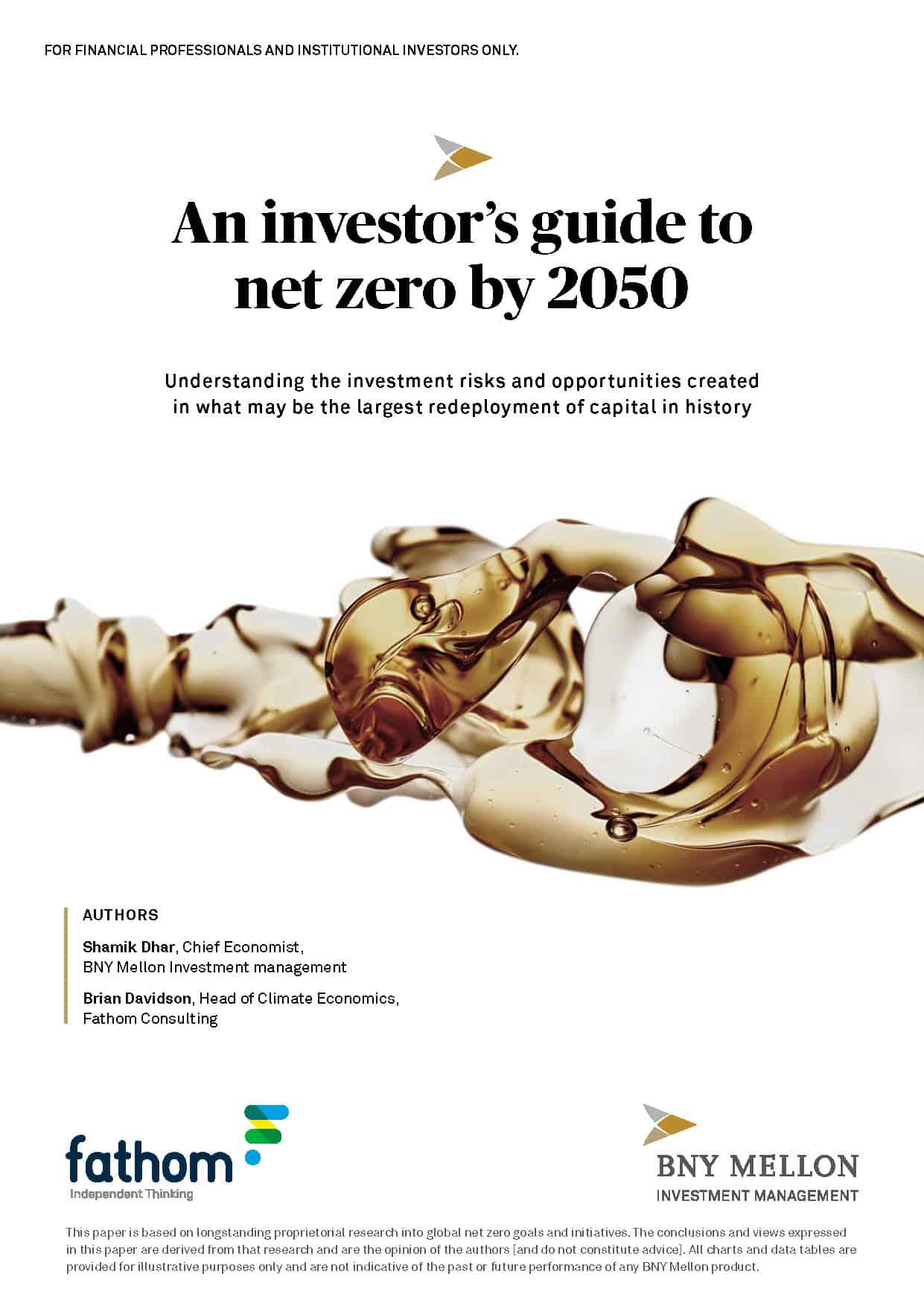Summary
The client asked Fathom to model how much investment was needed for the world to achieve the Paris climate goal of limiting global warming, and to frame the findings in a way that would be useful for investors. As the project progressed, the client expanded its remit to include quantifying and breaking down worldwide investment needs by country and transition risks by sector, in a systematic way that we believe has never been attempted before. The result was a highly usable piece of research of great practical relevance to investors and other stakeholders.
Key facts
Client
BNY Mellon Investment Management
Brief
Model the investment needed worldwide to achieve the Paris climate goal
Timescale
Phased over 15 months
Focus area
Climate economics
Our approach
Fathom applies the same rigorous, proven process to every piece of work; this process is the DNA that makes up our world-leading research.
The initial brief was to model the capital investment required worldwide to achieve the Paris climate goal. As we assessed the existing literature on the physical and transition costs of climate change, and the different existing modelling frameworks, it became clear that while numerous studies existed, none had yet taken a systematic approach from the macroeconomic perspective towards global investment needs. The International Energy Agency, for example, tells us the amount of investment in different energy systems required to get to net zero, but this is calculated from the bottom up rather than the top down, and covers only one part of the total picture.
Fathom’s approach differs by employing robust macroeconomic methodology. To answer the question we used a modified Cobb-Douglas approach, in which ‘clean’ and ‘dirty’ capital were identified – that is, assets that were already consistent with the transition, and assets that would need to be replaced for net zero to be accomplished – and simulated economic growth and changes in the capital stock, and its composition, in a business-as-usual and net-zero scenario.
As a result of our preliminary work the client decided to expand the brief in two ways, with an eye to increasing the practical value of the final report to its own investment clients. The first change was to include modelling the risks associated with the transition on a sector-by-sector basis — a new approach which adds clarity and perspective. The second was to map where investment was most needed, both geographically and on a sector-by-sector basis, which again we believe had not been attempted before and is of clear practical use to investors.
In collecting and cleaning the data for modelling, we drew on pre-existing Fathom research and expertise in creating our proprietary, sector-specific transition pathways. We identified investment needs and stranded asset risks by comparing sector-specific depreciation rates to decarbonisation pathways.
It is interesting to note that where other attempts have been made to form an overall estimate, in several instances the numbers aren’t a million miles away from the Fathom/BNY Mellon Investment Management study’s eventual finding of $100 trillion: for example, Mark Carney, the head of the GFANZ group, reached the same figure. This adds confidence, although we believe that our findings are the most robustly based of any international study to date.
Our study concluded that meeting the Paris climate goals could result in the largest redeployment of capital in history, with huge implications for a range of stakeholders, not least investors. Our study breaks down the investment needs and risks associated with the transition, helping investors manage risks and take advantage of the opportunities created by this process.
S&P 500 green investment required in net zero scenario, by sector
| Sector name | Investment, needed USD bn[1] | Investment, per cent of total | Market cap, per cent of total | PPE, USD bn[2] | Market cap to PPE ratio[2] |
|---|---|---|---|---|---|
| Energy | 3,113 | 26.6 | 2.8 | 847 | 1.2 |
| Utilities | 2,408 | 20.6 | 2.5 | 1,161 | 0.8 |
| Communication services | 705 | 6.0 | 11.2 | 828 | 5.0 |
| Capital goods | 655 | 5.6 | 5.9 | 193 | 11.3 |
| Materials | 511 | 4.4 | 2.8 | 260 | 4.0 |
| Automobiles & components | 478 | 4.1 | 2.0 | 184 | 4.0 |
| Health care | 441 | 3.8 | 12.9 | 288 | 16.5 |
| Information technology | 418 | 3.6 | 25.6 | 354 | 26.7 |
| Airlines | 418 | 3.6 | 0.3 | 135 | 0.8 |
| Retailing | 390 | 3.3 | 7.4 | 367 | 7.5 |
| Food & staples retailing | 327 | 2.8 | 1.8 | 210 | 3.2 |
| Air freight & logistics | 302 | 2.6 | 0.7 | 90 | 3.0 |
| Financials | 247 | 2.1 | 11.6 | 378 | 11.3 |
| Real estate | 229 | 2.0 | 2.4 | 456 | 2.0 |
| Road & rail | 226 | 1.9 | 1.0 | 130 | 2.7 |
| Hotels, resorts & cruise lines | 212 | 1.8 | 0.7 | 88 | 2.9 |
| Food products | 172 | 1.5 | 1.1 | 58 | 6.9 |
| Beverages | 133 | 1.1 | 1.5 | 40 | 13.9 |
| Household & personal products | 123 | 1.1 | 1.5 | 42 | 13.4 |
| Restaurants | 64 | 0.5 | 1.1 | 67 | 6.2 |
| Consumer durables & apparel | 54 | 0.5 | 1.1 | 26 | 16.2 |
| Commercial & professional services | 47 | 0.4 | 0.9 | 35 | 9.6 |
| Tobacco | 24 | 0.2 | 0.7 | 8 | 29.7 |
| Casinos & gaming | 21 | 0.2 | 0.3 | 73 | 1.5 |
| Total | 11,719 |
[2] Property, plant and equipment
Note: unless otherwise stated all market data refer to end 2021
Delivery
This was a joint enterprise with BNY Mellon Investment Management, and the approach, the issues and the results were agreed in close collaboration. Fathom’s high-quality, value-adding work was delivered in several stages: literature review; interim presentations; model-building; analysing results; and discussing takeaways. Findings were presented to the client and their stakeholders at an offsite meeting of senior investment executives.
The project’s findings were collected and published in a co-authored report; a media roundtable and launch event attracted significant media coverage.
Key findings
Using robust and repeatable methods, Fathom and BNY Mellon Investment Management’s joint research concluded that $100 trillion of ‘green’ investment would be needed by 2050 to meet the Paris climate goal. However, we were also able to show that a similar amount of investment would have occurred anyway, but in polluting assets, not clean assets. In a business-as-usual world, new polluting assets would be built to support future economic growth and replace the existing polluting capital stock as it depreciates. The size of total investment is not that different, but the nature of that investment is.
Other conclusions included:
- Investment in the net-zero transition will support future economic growth
- $20 trillion of polluting capital stock will need replacing or retrofitting before it reaches the end of its useful life: we call these ‘stranded assets’
- More than half of the $100 trillion investment is needed in emerging markets (EMs)
- Investing in EMs achieves more decarbonisation per dollar than investing in advanced economies
- The sectors by far the most exposed to transition risks are utilities, energy and airlines
- Energy and utilities will need nearly half of all corporate investment; they are two of the sectors most exposed to transition risks, and also the most polluting – this creates tensions for investors, especially those with an ESG or impact mandate
- Investors should not shun risk-exposed or polluting sectors, but should carefully pick companies that are serious about decarbonisation and have plans to manage transition risks
- Current levels of investment in non-polluting assets need to be scaled up
- The investment needs are huge, but we now know they are achievable
Impact
The project helped our client and their clients form a thorough understanding of the issues and investment implications related to net zero.
The client uses the results in its own analysis, and has shared them with its internal stakeholders, including senior investment executives of the various BNYM group investment companies. The report’s findings now inform investment strategy among these groups. They also inform the work being done by the client’s responsible strategy team.
The client also dispatched the report to the group’s institutional client base, giving its customers a deeper understanding of the issues, most notably investment opportunities and transition risks.
The widespread and positive coverage of the report in the media alerted the wider public to BNY Mellon Investment Management’s leadership in the economics of climate change and climate investing.
Report in the news
Get in touch
For more information about our services or to discuss your needs and how we can help, please submit the form below:



